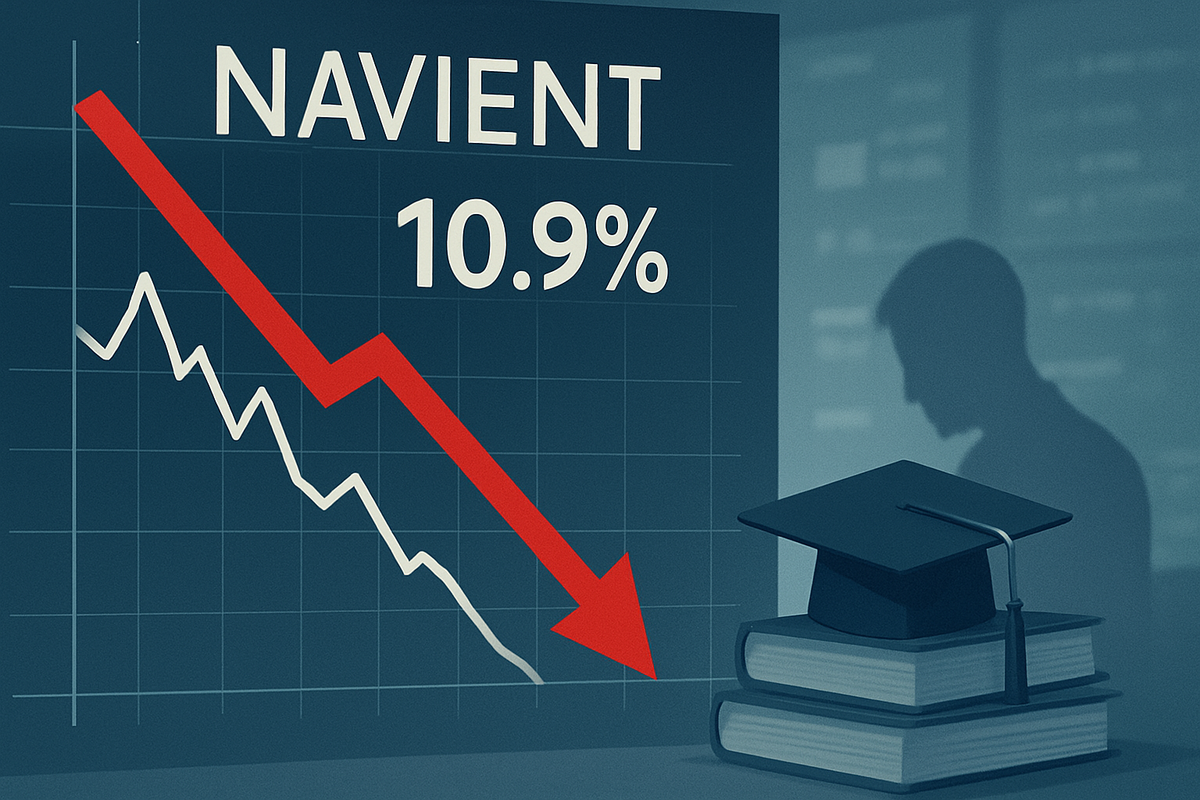
Alexandria, VA – October 29, 2025 – Student loan servicing giant Navient (NASDAQ: NAVI) saw its shares tumble by a significant 10.9% today following the release of its third-quarter 2025 financial results, which dramatically missed analyst expectations for both earnings and revenue. The sharp decline sent ripples through the financial markets, highlighting investor anxiety over the company's performance in a complex and evolving student loan landscape.
The immediate fallout from the earnings announcement was a palpable sense of disappointment among investors, leading to a swift sell-off. This substantial drop signals a re-evaluation of Navient's near-term prospects and underscores the challenges facing companies heavily invested in the student loan sector. The market's reaction suggests a lack of confidence in the company's ability to navigate current economic headwinds and regulatory shifts effectively.
Disappointing Q3 Performance Triggers Investor Exodus
Navient's third-quarter 2025 financial report, released on October 29, 2025, revealed a performance significantly below analyst consensus. The company reported a GAAP loss of $0.87 per share, a stark contrast to the anticipated profit of $0.17 per share, marking a substantial shortfall of $1.04 per share. Compounding the earnings miss, Navient's revenue for the period came in at $161 million, falling slightly short of the $162.8 million forecast by analysts.
The earnings call, held concurrently with the results announcement, delved into some of the underlying factors. While the Federal Education Loan segment saw an increase in net interest margin, this positive was overshadowed by a reduction in net interest income within the private legacy portfolio, attributed to lower prepayment rate assumptions. Additionally, while total delinquency rates showed a slight decline, the net charge-off rate experienced an increase, pointing to ongoing asset quality concerns.
This confluence of missed financial targets and underlying operational pressures triggered the severe market reaction. The 10.9% stock drop is particularly notable for Navient, a company not typically known for such volatile single-day movements, indicating the depth of investor concern. Prior to today's announcement, Navient's stock had already been down 10.7% year-to-date and was trading 25.9% below its 52-week high from November 2024, suggesting that today's news exacerbated an already precarious position for the company.
Navient Bears the Brunt, Competitors Watch Closely
The immediate and most significant loser from today's news is unequivocally Navient (NASDAQ: NAVI) itself. The substantial stock price decline directly impacts its market capitalization, investor confidence, and potentially its ability to raise capital or pursue strategic initiatives. A prolonged period of underperformance could lead to increased scrutiny from activist investors and pressure on management to demonstrate a clearer path to profitability and growth.
In the broader student loan servicing sector, competitors such as Sallie Mae (NASDAQ: SLM) and Nelnet (NYSE: NNI) will be closely monitoring Navient's struggles. While Navient primarily services federal and private student loans, Sallie Mae focuses more on private student loans, and Nelnet has a diverse portfolio including loan servicing, technology, and even telecom. Navient's challenges could be a cautionary tale for these companies, prompting them to re-evaluate their own risk exposure, operational efficiencies, and growth strategies. Depending on the specific drivers of Navient's disappointing results—whether it's sector-wide issues like rising delinquency rates or company-specific operational missteps—competitors could either face similar headwinds or potentially gain market share if Navient's difficulties persist. If the issues are Navient-specific, competitors might see an opportunity to capitalize on its weakened position, especially if they can demonstrate stronger asset quality or more robust servicing models.
Conversely, if Navient's struggles are indicative of broader pressures within the student loan industry, such as tighter regulatory environments, increased borrower defaults, or shifts in federal policy, then the entire sector could face a challenging period. This could lead to a reassessment of valuation multiples across the board and a more cautious approach from investors towards all companies operating in this space.
Broader Implications for the Student Loan Market
Navient's disappointing quarter is not an isolated event but rather fits into a broader narrative of an evolving and often turbulent student loan market. The past few years have seen significant shifts, including the extended federal student loan payment pause, subsequent resumption of payments, and ongoing discussions around loan forgiveness and affordability. These policy changes create an unpredictable operating environment for servicers like Navient, impacting revenue streams and increasing compliance costs. The rise in net charge-off rates, despite slightly declining delinquencies, suggests that some borrowers are struggling to manage their obligations, a trend that could worsen if economic conditions tighten.
The ripple effects could extend beyond direct competitors to other financial institutions involved in student lending or those with exposure to consumer credit. A weakening in the student loan sector could signal broader distress in household balance sheets, potentially affecting other forms of consumer debt. Regulatory bodies, already attentive to the student loan market, may intensify their oversight, potentially leading to new rules or enforcement actions that could further constrain profitability for servicers. Historically, periods of economic uncertainty have often led to increased defaults in various credit segments, and the student loan market is no exception. Comparisons can be drawn to previous cycles of consumer credit stress, where initial signs of weakness in one area often foreshadow broader challenges.
The long-term trend towards greater accountability for student loan servicers and increasing pressure for borrower relief also plays a significant role. Navient, having spun off from Sallie Mae in 2014, has been a key player in navigating these shifts. Today's results highlight the ongoing difficulty in balancing operational efficiency with the complex and often politically charged demands of student loan management. This event could prompt a re-evaluation of business models across the industry, pushing companies towards more diversified revenue streams or more robust risk management frameworks.
Navigating the Future: Strategic Pivots and Market Challenges
In the short term, Navient (NASDAQ: NAVI) faces intense pressure to articulate a clear strategy for regaining investor confidence. This will likely involve a detailed plan for improving profitability, managing asset quality, and potentially exploring new revenue streams outside of traditional loan servicing. Investors will be looking for concrete actions to address the identified weaknesses, such as optimizing operational costs or more aggressively managing its loan portfolios to mitigate further losses. The company may also need to provide revised guidance that is more aligned with current market realities to reset expectations.
Longer term, Navient may need to consider more significant strategic pivots. This could include further diversification of its business model, potentially by expanding into other financial services areas or leveraging its technology and servicing expertise in new markets. Given the ongoing regulatory scrutiny and the unpredictable nature of federal student loan policy, reducing its reliance on this segment could become a priority. Mergers and acquisitions, or even divestitures of underperforming assets, could also be on the table as the company seeks to streamline operations and enhance shareholder value.
The market opportunities that may emerge from this event could be for competitors who can demonstrate resilience and adaptability. If Navient struggles to recover, other servicers with stronger balance sheets or more innovative approaches to borrower engagement might be able to capture market share. However, the overarching challenge remains the inherent volatility and regulatory complexity of the student loan sector. Potential scenarios range from a gradual recovery for Navient if management can execute a successful turnaround, to continued underperformance if the structural issues are deeper than anticipated.
Key Takeaways and Investor Outlook
Navient's 10.9% stock decline following its disappointing Q3 2025 results serves as a critical warning signal for the student loan servicing industry. The substantial miss on both EPS and revenue, coupled with concerns over asset quality, underscores the ongoing challenges companies face in this sector. For Navient, the immediate task is to stabilize its performance and restore investor trust through transparent communication and a credible plan for improvement.
Moving forward, the market will be keenly watching several key indicators. Investors should pay close attention to Navient's subsequent earnings reports, looking for signs of operational improvements, a reduction in charge-offs, and progress on any strategic initiatives. The broader economic environment, particularly interest rate trends and unemployment figures, will also significantly influence borrower repayment capabilities and, by extension, the performance of student loan servicers. Furthermore, any new regulatory pronouncements or shifts in federal student loan policies could either provide tailwinds or create further headwinds for the industry.
In conclusion, while today's events represent a significant setback for Navient, they also highlight the dynamic nature of financial markets and the importance of adaptability in volatile sectors. The lasting impact will depend on Navient's ability to respond effectively to these challenges and the broader trajectory of the student loan market. Investors are advised to exercise caution and conduct thorough due diligence when considering positions in companies within this complex and evolving industry.
This content is intended for informational purposes only and is not financial advice





